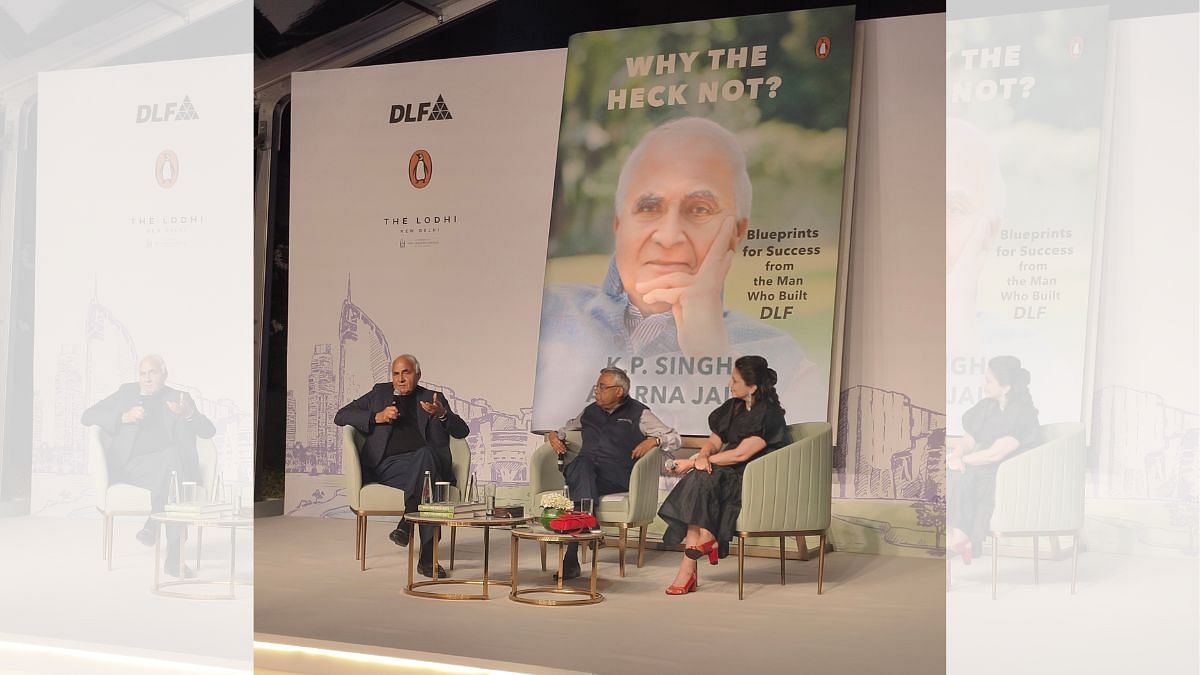New Delhi: The Supreme Court’s ruling earlier this month that not all private property can be acquired by the government under the pretext of public good has undone a “historical wrong” that saw farmers receive “ridiculously low” prices for their land, according to real estate developer DLF’s chairman emeritus K. P. Singh.
He said the old mindset of “think small” and that the public sector should handle real estate development set in motion the rise of unauthorised real estate developers and “fly-by-night” operators, bringing disrepute to the sector.
Many of these issues are only now being set right, through steps like the SC’s decision and the Narendra Modi government’s enactment of the Real Estate (Regulation and Development) Act, 2016, he added.
Speaking to select media Thursday ahead of the launch of his book ‘Why the Heck Not’—co-authored with Aparna Jain and published by Viking Penguin—Singh, 95, lamented about how public infrastructure in Gurgaon has not kept pace with growth in the city’s population density.
The reason for civic infrastructure not keeping up, he said, could be traced back to the 1950s.
“In urban development, you have to think at least 100 years ahead, not 20 years,” Singh said. “In the 1950s, when we got the Planning Commission, undoubtedly everything was about shortages in the country. So the dictum then was ‘think small and manage shortages’.”
However, he added, this mindset was also applied to urban infrastructure, either inadvertently or due to a lack of vision.
Also Read: Personal income tax now over 30% of govt’s tax revenue, significantly higher than corporate tax
Current woes result of lack of past vision
Singh explained that the application of this mindset to urban infrastructure was either inadvertent or due to a lack of vision because “in industry, if a mistake is made or a change needs to be made, it’s relatively easy.”
Adding that while industries and factories can always update themselves with changing times, he asserted that in urban infrastructure, such belated changes are next to impossible. “The water systems and drainage, etc., all start from thinking about how to shape up for the country to progress, not in the next 10-20 years, but a 100 years later.”
The mistake in the 1950s, he explained, was that the policymakers did not realise that India would be a vibrant economy.
“When you apply the ‘think small, manage shortages’ thinking to urban infrastructure, the whole thing becomes about small apartments, where families would have one car, one motorcycle, and so the width of the roads would be smaller,” he said.
However, once the area around narrow roads is built upon and buildings come up, and policymakers want to widen roads, how are they meant to do it, he asked. So when the entire area gets built up and roads are small, and you want to widen them, you cannot do anything, he explained.
“How do you demolish the buildings around the road?” he asked. “This ‘thinking small’, myopic vision completely destroyed the future.”
Public sector piles on the problems
Compounding this thinking, Singh said, was a belief in the government that the only way to reduce the price of housing and ensure that farmers were paid fairly for their land was to make real estate development the sole prerogative of public sector development authorities, such as with the Delhi Development Authority Rules, 1958.
“But urban infrastructure does not need only builders,” he said. “It needs people with vision, and the vision people are called developers. Developers need not be builders. If the heads of the development authorities come for just three years and are transferred, how will they understand the issues? It took me 40-50 years to understand them.”
This “mistake” led to the “exact opposite” of what the government wanted, he said.
“Farmers’ land was acquired at ridiculously low prices, which has been set right only now by the Chandrachud judgment, which said that now when you acquire land, you have to pay the real market value and not at low prices that they then pay to the farmers after 20 years,” he added.
“It was a historical wrong,” Singh said. “Because what was happening was that you acquired, for example, DLF’s land in 1961-62 and the compensation for which we got only in 1985-90. The farmers got nothing. This historical wrong has been set right.”
‘Jail, bail or bankrupt’
Singh further said that the public sector’s inability to cope with the rising demand for housing resulted in a “free-for-all” system.
“Because the public authorities could not cope with the demand, what emerged was a new tribe of people, which we call unauthorised developers or fly-by-night operators,” Singh said. “They paid off the town planners, etc, and built wherever they felt like. Slums are a direct result of this.”
“In 1982, I realised that the reputation of the real estate industry is so bad,” he lamented. “Everybody thought it was a sector of robbers, crooks, and cutting corners. Everybody was against us, including the public, media and judiciary. They were right.”
This perception, he said, encouraged him to bring about a draft version of a real estate regulation act in 1983, but that there were “vested interests” which prevented it. This continued until the Modi government enacted the Real Estate (Regulation and Development) Act in 2016, he added.
“And what happened as a result?” Singh asked. “A transformation is taking place now. (Around) 90% of old builders and developers are either in jail, bail or bankrupt. But a new breed is coming up now, which is the future of India. They are compliant with the RERA law and will drive the real estate sector (to a level) as good as any other industry. No shortcuts, no hanky panky.”
(Edited by Radifah Kabir)
Also Read: Fiscal boost can’t rely on spending cuts alone, Modi govt must consider non-tax measures

